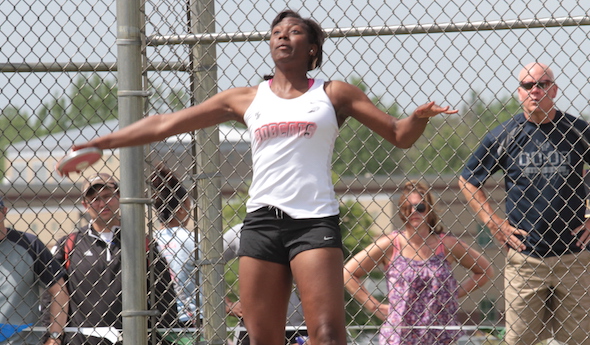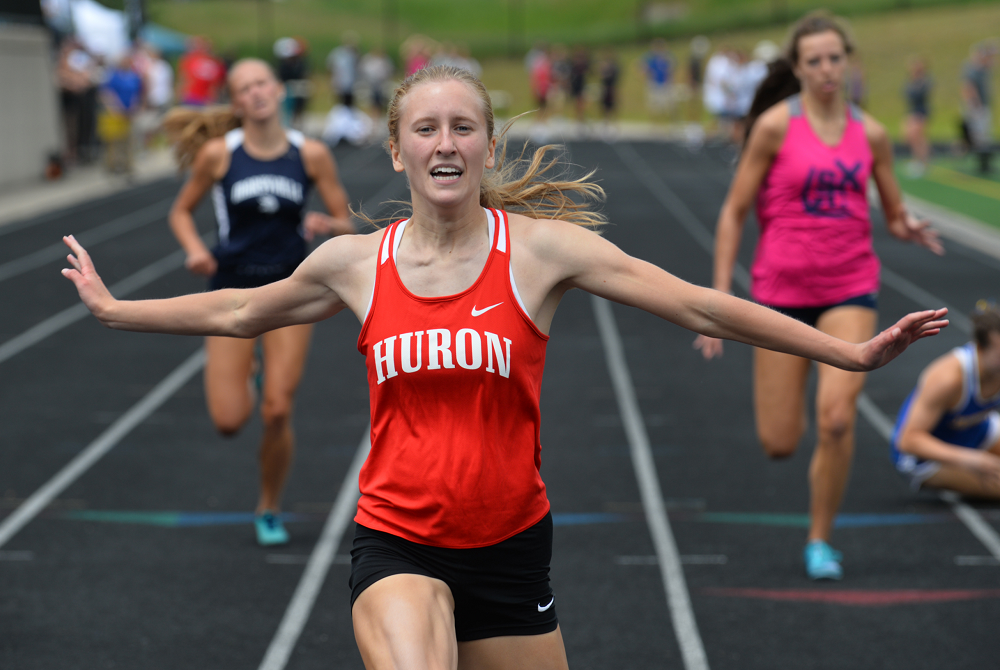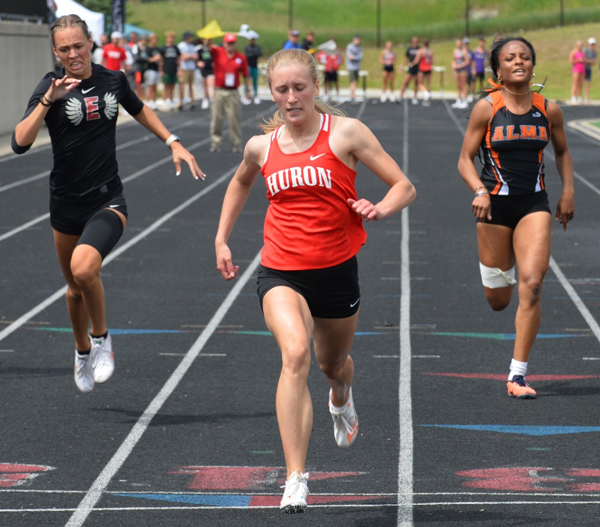
Talent Plus Form Equal Wheeler's Stardom
By
Paul Costanzo
Special for MHSAA.com
March 16, 2017
It was cold and rainy on April 29, 2016, and Grand Blanc’s Quiara Wheeler was scared.
 The line to make to even have your throw measured in the discus at the Charlie Janke Track & Field Invitational in Jackson was 80 feet, farther than her personal best.
The line to make to even have your throw measured in the discus at the Charlie Janke Track & Field Invitational in Jackson was 80 feet, farther than her personal best.
“I was really nervous, because I couldn’t throw very far,” she said. “I threw an 88-4 and was really excited. The week after that I started throwing farther in practice. (Grand Blanc throwing coach Garner Pleasant) and I figured out I was holding it wrong the whole season, then I figured out the hand placement and my footwork.”
After that, she took off.
Wheeler went from scared to be short of the minimum measurement to MHSAA champion in a little more than 30 days, throwing 136 feet, 2 inches on June 4 to win the Lower Peninsula Division 1 title.
“Sometimes they will get a big improvement in the disc because all of the sudden it just clicks,” Grand Blanc girls track & field coach Andy Taylor said. “But it usually takes at least a year or more to do that. To improve 50 feet from the end of April to the state meet, I’ve never heard of that.”
Wheeler improving her personal best by more than 60 feet in one season, and her quick ascension to the top of the state’s pecking order in the discus are actually easier to explain than you would guess.
It was a simple formula: extraordinary talent meets proper form – or close to it, anyway.
“What God has put in her, I can’t put in her,” Pleasant said. “She’s an athlete.”
Wheeler doesn’t just throw for the Bobcats, she also long jumps, with a personal best of 16 feet, and has been on the sprint relays.
She holds a third-degree black belt in martial arts, and her coaches feel that background has helped her to quickly pick things up on the track.
“She’s used to putting in the work and having discipline,” Taylor said. “At the state meet, as she was throwing, I happened to look right in her eyes, and you could tell that she was totally focused.”
While her improvement was lightning fast, it was also gradual, and not without some bumps in the road. In early May, her throws crept into the low 100s – 100-4, 102-1, 113-11 – from May 3 to 10.
Before the Kensington Lakes Activities Association meet, Pleasant decided to add a full spin to Wheeler’s arsenal. She faulted three times, however, and did not record a throw.
“I told her, ‘Forget about it, put it behind you,’” Pleasant said. “When we get ready for the Regional, we’re going to do the South African (technique). At the Regional, she throws the discus 120 feet with a legal South African, and that had to go about 150 feet straight in the air and dropped.
“We had two weeks before the state meet, so all we did is work on the full rotation. That’s all we did for two full weeks.”
 The new technique helped Wheeler reach 132 feet in the preliminary rounds of the Division 1 meet, easily putting her into the Finals.
The new technique helped Wheeler reach 132 feet in the preliminary rounds of the Division 1 meet, easily putting her into the Finals.
Still, the newcomer to the big stage felt the nerves.
“When it came to the Finals, I was by myself and I was trying to calm myself down the whole time,” Wheeler said. “It was kind of overwhelming at first because all of the girls were so good and I was like, ‘How did I make it to the Finals?’”
Wheeler won by five feet, with no one else topping even her preliminary throw.
Her rapid rise caught the eyes of college coaches, and she said she has scholarship offers from Western Michigan University and Heidelberg University in Ohio. Taylor said college coaches are excited about how much more she can grow.
“I actually never really thought about (throwing in college),” she said. “This was before I was good. When the season was going on, I realized maybe I can do this. But I definitely want to continue this in college.”
Pleasant and Taylor both feel Wheeler is only beginning to tap into her potential as a thrower. She’s dedicated her offseason to getting better in the discus, which doesn’t bode well for those trying to catch her.
“I’ve just been training every day, pretty much since October – I also trained in the summer,” she said. “I’ve been lifting weights, and I’m definitely stronger than I was last year. I work out with two other boys, and they push me because they’re stronger than me. I go in and watch videos, footage of me sometimes and how bad my form was. Coming into the season, I’m hoping to be more consistent with my throws.”
Wheeler doesn’t seem worried that she’ll now have a target on her back as the returning Finals champion. In fact, she’s excited to beat her previous achievements, which is what drew her to track in the first place.
Pleasant has her aiming for the stars.
“I told her, ‘You should be setting your sights on the best marks in the state,’” Pleasant said. “That’s what we’re shooting for, having the best marks in the state. It’s not about state, it’s about going out and trying to have some of the best marks in the nation if you can.”
 Paul Costanzo served as a sportswriter at The Port Huron Times Herald from 2006-15, including three years as lead sportswriter, and prior to that as sports editor at the Hillsdale Daily News from 2005-06. He can be reached at [email protected] with story ideas for Genesee, Lapeer, St. Clair, Sanilac, Huron, Tuscola, Saginaw, Bay, Arenac, Midland and Gladwin counties.
Paul Costanzo served as a sportswriter at The Port Huron Times Herald from 2006-15, including three years as lead sportswriter, and prior to that as sports editor at the Hillsdale Daily News from 2005-06. He can be reached at [email protected] with story ideas for Genesee, Lapeer, St. Clair, Sanilac, Huron, Tuscola, Saginaw, Bay, Arenac, Midland and Gladwin counties.
PHOTOS: (Top) Grand Blanc’s Quiara Wheeler tosses the discus during last season’s Lower Peninsula Division 1 Finals. (Middle) Wheeler enjoys a moment away from the throwing circle. (Photos by John Brabbs/RunMichigan.com.)

Multi-Sprint Champ Racing to Finish Huron Career Ahead of the Rest Again
By
Keith Dunlap
Special for MHSAA.com
May 25, 2023
NEW BOSTON – If there was one thing Elizabeth Anderson took pride in elementary school, it was simply showing that she could outrun everyone in sight.
 In fact, Anderson has an explanation for all the success she had in those playground races.
In fact, Anderson has an explanation for all the success she had in those playground races.
“Dominance when you are in elementary school,” Anderson quipped. “I don’t think I ever had a nickname. I just think everyone knew I was fast.”
Years later, pretty much everyone who follows track & field in the state of Michigan can attest to that.
A senior for New Boston Huron, Anderson has been faster than most other competitors in the state during her three-year high school career (with her freshman season in 2020 canceled due to COVID-19).
Last year, Anderson won titles at the Lower Peninsula Division 2 Finals in the 200-meter (25.07) and 400-meter (56.28) dashes, and was runner-up in the 100-meter dash (12.23).
Often, top sprinters focus on one or two of those three races. But Anderson is certainly a different breed of sprinter because she does all three.
In fact, she holds school records in all three of those events, and if all that weren’t enough, Anderson is a part of all three sprint relay teams.
“It is hard to give her events off,” said New Boston Huron head girls track coach Danielle Lobato.
Despite the different styles the 100, 200 and 400-meter dashes present, Anderson said there usually isn’t much adjusting when she goes from one of those races to another.
 The strategy is simply, “Let’s beat the other girls to the finish line.”
The strategy is simply, “Let’s beat the other girls to the finish line.”
“I don’t really go into each race changing up how I would run,” she said.
While enjoying and succeeding in all three races, Anderson said she actually does have a favorite among them.
“I would say the 400 is probably my favorite,” she said. “Even though it hurts, it’s satisfying to see how much you can get your time down in the 400 compared to any other race.”
Anderson said she started running track in sixth grade, but really got serious about it during the summer after her sophomore season, when she was invited to run for a local club.
Eventually, that led to her competing over the winter in indoor events.
She lived and breathed track so much that last fall, she decided to not run cross country so she could focus on a weightlifting regimen aimed at developing more leg strength.
“Once I started doing summer track, I realized I wanted to be doing this all the time,” she said.
Lobato said oftentimes in practice, Anderson is a de facto coach, given there is no better person she can think of for the younger runners on the team to learn from.
“I can’t always demonstrate these things I’m trying to teach,” she said. “You get to see it in real life (from Anderson), not in a YouTube video.”
After winning the 100, 200 and 400-meter dashes at her Regional meet last week, Anderson has her sights set on achieving the same trifecta of titles at next Saturday’s Finals in Grand Rapids.
Anderson has signed to run track at Michigan State, but has been plenty motivated to keep producing this spring in her final high school season.
“I’m really looking to defend my titles,” she said. “That is what is really motivating me to keep going. I want to keep in shape for the college season. I don’t want to lose any of the progress I have made. Ultimately, I just love running track.”
And since elementary school, Anderson has loved — and succeeded in — outrunning everyone else to the finish line.
“We knew we were getting something special,” Lobato said of when Anderson arrived in high school. “But you never expect this. All that she has accomplished is amazing.”
 Keith Dunlap has served in Detroit-area sports media for more than two decades, including as a sportswriter at the Oakland Press from 2001-16 primarily covering high school sports but also college and professional teams. His bylines also have appeared in USA Today, the Washington Post, the Detroit Free Press, the Houston Chronicle and the Boston Globe. He served as the administrator for the Oakland Activities Association’s website from 2017-2020. Contact him at [email protected] with story ideas for Oakland, Macomb and Wayne counties
Keith Dunlap has served in Detroit-area sports media for more than two decades, including as a sportswriter at the Oakland Press from 2001-16 primarily covering high school sports but also college and professional teams. His bylines also have appeared in USA Today, the Washington Post, the Detroit Free Press, the Houston Chronicle and the Boston Globe. He served as the administrator for the Oakland Activities Association’s website from 2017-2020. Contact him at [email protected] with story ideas for Oakland, Macomb and Wayne counties
PHOTOS (Top) New Boston Huron's Elizabeth Anderson clears the finish line during last season's LPD2 400 race. (Middle) Anderson, middle, outpaces the field to also win the 200. (Click for more from RunMichigan.com.)

